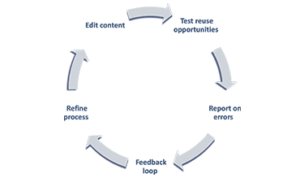Article
PIM-Systems based on knowledge graphs
Industries rely on Product Information Management (PIM) systems to create, manage, and distribute product information across various channels. Traditional PIM platforms encounter numerous issues due to the complexity of product portfolios and increasing heterogeneity of data sources. Moreover, there is a need to compare competitors’ product offerings with the current product offering to achieve market and portfolio intelligence. Other issues include inconsistent data quality and cumbersome manual workflows faced by sales managers when there is no centralized source of truth. This leads to inefficiencies in accessing necessary product data by company departments, which is detrimental to decision-making and competitiveness. We can address these challenges by developing PIM systems based on knowledge graphs.
Business Use Case: Product Navigator for Sales Managers
Sales managers often face the difficult task of collecting product offering information from various sources, a time-consuming and error-prone process. In addition to navigating internal data sources, they are responsible for manually tracking competitors’ product offerings across different external websites. This complexity makes it difficult to find information quickly, negatively impacting strong customer relationships and competitiveness. To address these issues, we use a knowledge graph as the core of the PIM system. It integrates product information from various data silos, represented in a unified structure in a central location. The product navigator serves as a tailored access point to the knowledge graph, catering to the specific needs of sales managers.
PIM System Architecture
The PIM system architecture consists of four main layers: data sources, data onboarding, middleware, and content delivery.

Data Sources
We distinguish between structured and unstructured data. Unstructured data includes technical documents and competitors’ websites. These are used to extract specific product details and descriptions that are stored as RDF in the knowledge graph. Structured data consists of product datasheets and relational data sources containing predefined attributes for product properties such as efficiency and rating.
Data Onboarding
In the data onboarding layer, competitors’ product data is continuously extracted and stored in the PIM knowledge graph. This involves document crawling, classification, data extraction, and RDF generation. We scrape competitors’ websites to gather technical product documents. Relevant information is extracted using a trained OCR model. Structured data from relational databases is transformed and integrated into the knowledge graph. This pipeline operates automatically and includes data validation.
Middleware
The ontology and taxonomy manager maintains the PIM ontologies and taxonomies. The relational database stores operational data such as access and control lists. The knowledge graph stores all RDF data in interconnected graphs, enhancing RDF query efficiency. The API server defines a set of API calls used by the content delivery layer for various applications, including the product navigator web application.
Content Delivery
The content delivery layer is responsible for presenting the integrated and processed data to end-users. It includes web interfaces, mobile applications, and integration with other enterprise systems. This layer ensures that the right data is accessible to the right people at the right time, providing a seamless user experience. It supports advanced search and visualization tools, enabling sales managers and other users to easily access and utilize the consolidated product information for decision-making and strategic planning.
Benefits of Knowledge Graphs for PIM Systems
- Data Integration: Knowledge graphs enable the integration and consolidation of product information from various data sources and silos. This ensures a unified and centralized data base, minimizing inconsistencies and improving data quality.
- Flexibility and Scalability: The flexible structure of knowledge graphs allows for the easy addition and management of new data sources and product attributes. This is especially important in dynamic markets where product portfolios and requirements can change rapidly.
- Advanced Query Capabilities: Knowledge graphs support complex queries and analyses beyond simple data retrieval. Sales managers can, for example, conduct detailed comparisons of product features and market segments, leading to more informed decisions.
- Automation and Efficiency: Centralized management and automatic updating of product information reduce manual workflows. This increases efficiency and reduces error rates, benefiting sales and marketing teams in particular.
- Enhanced Competitive Analysis: Knowledge graphs enable detailed tracking and analysis of competitors’ product offerings. This information can be directly integrated into the PIM system, providing companies with a competitive advantage.
- Easy Maintenance and Expansion: By using standardized ontologies and taxonomies, PIM systems based on knowledge graphs are easier to maintain and expand. This leads to better long-term sustainability and adaptability of the system.
In summary, knowledge graphs offer a robust and flexible platform for PIM systems, significantly improving both data management and decision-making. They help increase efficiency, ensure data quality, and make companies more competitive. These benefits make knowledge graphs an ideal choice for modern PIM solutions.
Read the paper “Product Information Management Systems Powered by Knowledge Graphs“.
Amir Laadhar and Nikhil Acharya, Knowledge Engineers at PANTOPIX, presented on this topic at the ESWC 2024 in Crete.
Subscribe to the free newsletter from PANTOPIX. We will keep you regularly up to date on events, webinars, news and trends in technical communication.

From Legacy Systems to DITA: Case Studies in Successful Migration
This article explores real-world insights and lessons learned from successful migration projects, based on two case studies facilitated by PANTOPIX.

Knowledge Graphs and Large Language Models: the perfect combination!
Out-of-the-box solutions for RAG systems are becoming increasingly widespread. They promise to make a company’s knowledge accessible from documents such as PDFs or Word files using Large Language Models (LLMs) in the form of a chat.

Semantic layers of the Product Information Management Systems (PIM)
Companies rely on Product Information Management (PIM) systems to create, manage, and distribute product information across various channels. We can offer PIM systems software solutions for our industrial clients.
Contact us
Prof. Dr. Martin Ley
Partner and Senior Consultant
- martin.ley@pantopix.com
